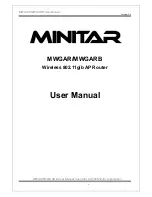
Deployment Guide
177
H
IVE
OS C
ONFIGURATION
F
ILE
T
YPES
H
IVE
OS C
ONFIGURATION
F
ILE
T
YPES
HiveOS supports several types of configuration files: running, current, backup, bootstrap, default, and failed.
The running configuration (config) is the configuration that is actively running in DRAM. During the bootup process,
a HiveAP loads the running config from one of up to four config files stored in flash memory:
•
current: a flash file containing a combination of default and admin-defined settings. During the bootup process,
this is the first config that the HiveAP attempts to load as the running config. This is also the file to which you
typically save commands from the running config (you can also save them to the bootstrap config). See
Figure 3
.
•
backup: a flash file that the HiveAP attempts to load during the reboot process if there is a newly uploaded
current config file or if it cannot load the current config file. See
Figure 4 on page 178
and
Figure 5 on
page 178
.
•
bootstrap: a flash file containing a second config composed of a combination of default and admin-defined
settings. The HiveAP fails over to this config when you enter the
reset config
command or if both the
current and backup config files fail to load. See
Figure 6 on page 180
.
•
default: a flash file containing only default settings. If there is no bootstrap config, the HiveAP reverts to this
config when you enter the
reset config
command or if both the current and backup config files fail to load.
See
Figure 6 on page 180
.
When using the CLI, the two most frequently accessed config types are the running config and current config. When
you enter a command in the running config, the HiveAP performs it immediately. However, because the running
config is stored in volatile memory (DRAM), the commands are not yet permanent and will be lost when the HiveAP
next reboots. For your configuration settings to persist after rebooting, enter the
save config
command. This
command saves the running config to the current config, which is a file stored in nonvolatile (flash) memory. See
Figure 3
.
Figure 3
Relationship between running and current config files
Note:
There is also a failed config file, which holds any backup config that fails to load. See
Figure 5 on
page 178
.
(Note: The commands in
bold
have not yet been saved,
which is why they do not appear in the current config.)
Current Config
(in flash memory)
Running Config
(in DRAM)
The running config comprises the current config
plus any commands that have not yet been
saved. The running config runs in DRAM.
The current config comprises saved
commands plus default settings. The
current config is stored in flash memory.
Running Config
New Current Config
Previous Current Config
(overwritten)
When you enter the
save config
save config
command,
the HiveAP saves the running config from
DRAM to flash memory, where it becomes
the new current config, replacing the one
previously there.
save config
(Note: After entering the
save
save
confi
config
command, the current and
running configs become identical.)
Summary of Contents for access point
Page 1: ...Aerohive Deployment Guide ...
Page 7: ...HiveAP Compliance Information 6 Aerohive ...
Page 13: ...Contents 12 Aerohive ...
Page 37: ...Chapter 2 The HiveAP 20 ag Platform 36 Aerohive ...
Page 71: ...Chapter 4 The HiveAP 340 Platform 70 Aerohive ...
Page 81: ...Chapter 5 The HiveAP 320 Platform 80 Aerohive ...
Page 105: ...Chapter 8 The High Capacity HiveManager Platform 104 Aerohive ...
Page 123: ...Chapter 10 Using HiveManager 122 Aerohive ...
Page 209: ...Chapter 14 Deployment Examples CLI 208 Aerohive ...
















































